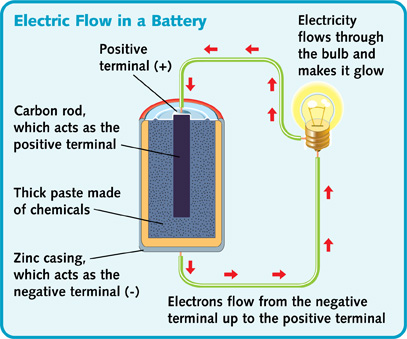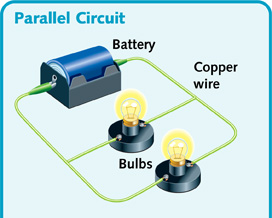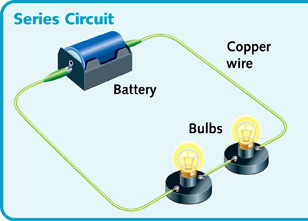Ampere - The ampere is the standard unit of measure of electric current. It is sometimes written as amp.
Alternating current (AC) - An electric current that reverses direction on a periodic basis. It is widely used to transport power on power lines.
Battery - A device that stores and produces electricity from chemical cells. A battery has chemicals inside it. The battery is linked to a circuit. Then the chemicals inside the battery react together. This pushes a flow of electrons around the circuit.

Capacitor - A basic electrical component that stores electric charge. Capacitors are made from two electrical conductors separated by an insulator.
Closed Circuit - circuit in which an electric current can flow from the power source to an object & back to the power source in an unbroken path
 simple closed circuit
simple closed circuitConductivity - ability of an object to conduct or transmit heat, electricity, or sound
Conductor - material that can allow heat, light, sound, or electricity to pass through it easily.
- Example: Metal is a good conductor of heat & electricity because it transmits them so easily (A material that allows the free flow of electric charge. Copper wiring is the most widely used electrical conductor.)
Current electricity - the flow of electrons through a continuous path, or loop, from a power source & back to the power source.
Diode - An electronic component that only allows current flow in one direction.
Direct current (DC) - A type of current that only flows in one direction (unlike AC which periodically reverses direction).
Dry cell battery - batteries that use paste-like chemicals to produce electricity
- Example: used to power watches, toys, remote controls, portable radios, cell phones, calculators, flashlights
- some dry cell batteries can be recharged
Electric charge - This is a basic characteristic of matter that is based on the balance of protons (positive charge) and electrons (negative charge). The standard unit for electric charge is the coulomb.
Electric circuit - An electric circuit is a collection of electronic components connected by a conductive wire that allows for electric current to flow.
Electric current - Electric current is the flow of electric charge through a material. The standard unit for electric current is the ampere.
Electricity - form of energy produced when electrons move, or flow, from one atom to another atom. There are two types of electricity - static electricity & current electricity.
Electric potential - The electric potential is the difference in electrical charge between two points in a circuit. It is also called the voltage. The standard unit for electric potential is volts.
Electromagnetism - The interaction between magnetic fields and electric currents.
Electron - A basic subatomic particle found in all atoms, electrons carry electricity by flowing from one atom to the next in a conductive material.
Insulator - A material in which electronic charge does not flow freely and does not conduct the flow of electric current, heat, light, or sound.
- Example: Rubber is a good insulator for both electricity & heatIf one light bulb (or resistor) is turned off or breaks, the current will follow the other path.
Ohm - The standard unit of measure for resistance.
Ohm's law - A law of physics that describes the relationship between voltage, current, and resistance using the equation V = IR.
Open Circuit - circuit in which an electric current cannot flow from the power source to an object & back to the power source
caused by a break in the circuit; switch is turned off & electric current is stopped at the switch

Parallel Circuit - electric circuit that has more than one path for the current to follow.

In a parallel circuit, electricity can pass along different paths to power different loads.
Pole - the ends of a battery (positive pole & negative pole) & a magnets (north & south pole).
Resistance - measure of how much a materiel slows down or stops electricity. measured in ohms
Example: Rubber has higher resistance so it is a poor conductor of electricity. Copper has low resistance so it is a good conductor of electricity.
Calculating Resistance
Use the formula R = V/I
R = resistance (ohms)
V = voltage (volts)
I = current (amps)
Resistor - A basic electronic component that prevents the flow of electric current.
Semiconductor - A material that behaves between a conductor and an insulator depending on the conditions. Silicon is a widely used semiconductor in electronics.
Series Circuit - electric circuit that has only one path for the current to follow. If one light bulb (or resistor) is turned off or breaks, the path is broken & the current will stop.

A series circuit has only one path of electricity. It provides power for more than one electrical load.
Static electricity - The build up of an electric charge on the surface of an object. The charge remains in one area rather than flowing to another area. Rubbing together two objects made of different materials can produce static electricity.- Example: static electricity can be produce when a latex balloon is rubbed on a wool sweater. Lightning
Transistor - A semiconductor device used in an electric circuit to regulate current flow to act as a gate, switch, or amplifier for electronic signals.
Volt - The standard unit of measure for electric potential (voltage).
Watt - The standard unit of measure used for electric power.
Wet cell battery - batteries that use liquid chemicals to produce electricity
They are usually about twice the size of a shoe box.
Wet-cell batteries contain lead and a solution of sulfuric acid.
Conductors and insulators - Conductors are materials that allow electricity to flow easily. Most types of metal are good conductors, which is why we use metal for electrical wire. Copperis a good conductor and isn't too expensive, so it's used a lot for the wiring in homes today. Insulators are the opposite of conductors. An insulator is a material that doesn't carry electricity. Insulators are important because they can protect us from electricity. Materials like rubber, plastic, and paper are good insulators.
ELECTRIC VOCAB TERM - ACTIVITY


